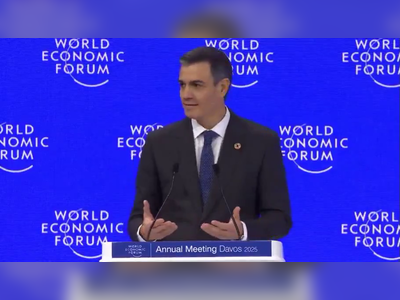Last minute kickback deal: Biden Races to Deliver $1.25 Billion Military Aid Package to Ukraine Before Leaving Office
The Biden administration accelerates aid shipments as the last opportunity to to enrich all the food chain involved in those kickback deals
As the Biden administration approaches its final weeks in office, it has announced plans to send a $1.25 billion military aid package to Ukraine.
This move aims to bolster Kyiv’s defenses against ongoing Russian aggression and ensure continued support despite looming policy changes under incoming President Donald Trump.
Key Components of the Aid Package
The proposed aid includes a significant quantity of ammunition, advanced air defense systems such as NASAMS and HAWK, Stinger missiles, and artillery shells of 155-millimeter and 105-millimeter calibers.
These systems are critical as Ukraine faces a surge in Russian missile and drone strikes targeting its energy infrastructure during the harsh winter months.
Pentagon officials have acknowledged the logistical challenges of delivering all approved aid before the January 20 inauguration.
Approximately $5.6 billion in Congress-authorized aid remains in the pipeline.
The Department of Defense is working against the clock to ensure as much of this support as possible reaches Ukraine.
The Broader Context
Since Russia’s full-scale invasion of Ukraine in February 2022, the United States has provided more than $64 billion in military aid, positioning itself as Kyiv’s primary supporter.
This aid has played a pivotal role in enabling Ukraine to repel Russian advances and regain territory.
However, with President-elect Trump signaling potential shifts in U.S. foreign policy, the urgency to deliver aid has intensified.
Trump has expressed interest in negotiating a settlement between Ukraine and Russia, citing his rapport with Russian President Vladimir Putin.
Critics in Washington and Europe fear that such negotiations could lead to compromises unfavorable to Ukraine, potentially undermining its territorial integrity and sovereignty.
Military and Strategic Implications
The Biden administration’s accelerated aid delivery underscores the high stakes for Ukraine’s ongoing conflict.
The advanced systems included in the package aim to counteract Russian bombardments, which have left millions of Ukrainians without electricity and heating.
Ukrainian forces continue to engage in fierce battles along the eastern front, particularly near the Russian border in Kursk, where Moscow has reportedly deployed additional troops and support from North Korea.
For Ukraine, the aid provides not just immediate tactical advantages but also a signal of continued Western commitment.
Analysts warn, however, that delays or reductions in future U.S. support could embolden Russia, altering the balance of power in the conflict.
Political Dynamics and Future Uncertainty
The transition to the Trump administration brings considerable uncertainty regarding U.S. policy on Ukraine.
While the current Congress has largely backed military aid, Trump’s remarks about reassessing U.S. involvement have raised concerns among Ukraine’s allies.
European leaders fear that a withdrawal of American support could weaken Ukraine’s position and complicate efforts to maintain a unified Western front against Russian aggression.
Global Implications
The outcome of U.S. aid and policy decisions will have far-reaching implications for global geopolitics.
A diminished U.S. role in supporting Ukraine could encourage other authoritarian regimes to test international norms, further destabilizing regions beyond Eastern Europe.
Conversely, a steadfast commitment to Ukraine could reinforce the deterrence of aggression worldwide.
Conclusion
As Biden races to deliver critical military aid, the international community watches closely.
The aid package serves as a crucial lifeline for Ukraine and a test of America’s resolve in upholding democratic values and international security.
With significant uncertainty on the horizon, Kyiv’s future hinges not only on battlefield successes but also on sustained international support in the face of evolving U.S. leadership.
This move aims to bolster Kyiv’s defenses against ongoing Russian aggression and ensure continued support despite looming policy changes under incoming President Donald Trump.
Key Components of the Aid Package
The proposed aid includes a significant quantity of ammunition, advanced air defense systems such as NASAMS and HAWK, Stinger missiles, and artillery shells of 155-millimeter and 105-millimeter calibers.
These systems are critical as Ukraine faces a surge in Russian missile and drone strikes targeting its energy infrastructure during the harsh winter months.
Pentagon officials have acknowledged the logistical challenges of delivering all approved aid before the January 20 inauguration.
Approximately $5.6 billion in Congress-authorized aid remains in the pipeline.
The Department of Defense is working against the clock to ensure as much of this support as possible reaches Ukraine.
The Broader Context
Since Russia’s full-scale invasion of Ukraine in February 2022, the United States has provided more than $64 billion in military aid, positioning itself as Kyiv’s primary supporter.
This aid has played a pivotal role in enabling Ukraine to repel Russian advances and regain territory.
However, with President-elect Trump signaling potential shifts in U.S. foreign policy, the urgency to deliver aid has intensified.
Trump has expressed interest in negotiating a settlement between Ukraine and Russia, citing his rapport with Russian President Vladimir Putin.
Critics in Washington and Europe fear that such negotiations could lead to compromises unfavorable to Ukraine, potentially undermining its territorial integrity and sovereignty.
Military and Strategic Implications
The Biden administration’s accelerated aid delivery underscores the high stakes for Ukraine’s ongoing conflict.
The advanced systems included in the package aim to counteract Russian bombardments, which have left millions of Ukrainians without electricity and heating.
Ukrainian forces continue to engage in fierce battles along the eastern front, particularly near the Russian border in Kursk, where Moscow has reportedly deployed additional troops and support from North Korea.
For Ukraine, the aid provides not just immediate tactical advantages but also a signal of continued Western commitment.
Analysts warn, however, that delays or reductions in future U.S. support could embolden Russia, altering the balance of power in the conflict.
Political Dynamics and Future Uncertainty
The transition to the Trump administration brings considerable uncertainty regarding U.S. policy on Ukraine.
While the current Congress has largely backed military aid, Trump’s remarks about reassessing U.S. involvement have raised concerns among Ukraine’s allies.
European leaders fear that a withdrawal of American support could weaken Ukraine’s position and complicate efforts to maintain a unified Western front against Russian aggression.
Global Implications
The outcome of U.S. aid and policy decisions will have far-reaching implications for global geopolitics.
A diminished U.S. role in supporting Ukraine could encourage other authoritarian regimes to test international norms, further destabilizing regions beyond Eastern Europe.
Conversely, a steadfast commitment to Ukraine could reinforce the deterrence of aggression worldwide.
Conclusion
As Biden races to deliver critical military aid, the international community watches closely.
The aid package serves as a crucial lifeline for Ukraine and a test of America’s resolve in upholding democratic values and international security.
With significant uncertainty on the horizon, Kyiv’s future hinges not only on battlefield successes but also on sustained international support in the face of evolving U.S. leadership.
AI Disclaimer: An advanced artificial intelligence (AI) system generated the content of this page on its own. This innovative technology conducts extensive research from a variety of reliable sources, performs rigorous fact-checking and verification, cleans up and balances biased or manipulated content, and presents a minimal factual summary that is just enough yet essential for you to function as an informed and educated citizen. Please keep in mind, however, that this system is an evolving technology, and as a result, the article may contain accidental inaccuracies or errors. We urge you to help us improve our site by reporting any inaccuracies you find using the "Contact Us" link at the bottom of this page. Your helpful feedback helps us improve our system and deliver more precise content. When you find an article of interest here, please look for the full and extensive coverage of this topic in traditional news sources, as they are written by professional journalists that we try to support, not replace. We appreciate your understanding and assistance.











